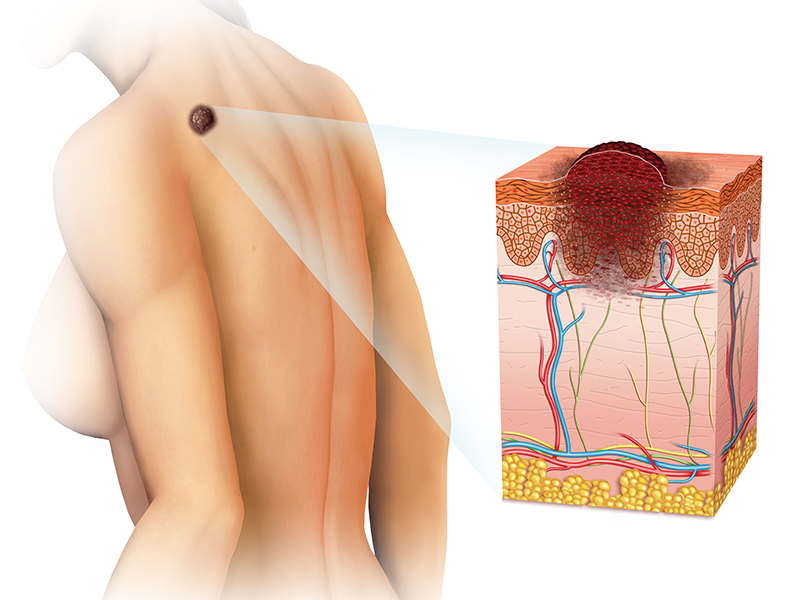Skin cancers can typically be broken into three types: basal cell carcinoma, squamous carcinoma and melanoma.
Basal and Squamous Cell Carcinoma
Basal cell carcinoma and squamous cell carcinoma are the most common forms of skin cancer. They are rarely fatal and most often found in people with fair skin, although they can be found in people of all skin types. Those with a history of chronic sun exposure and sunburns are at increased risk. These skin cancers normally present on sun-exposed areas as a red bump, scaly patch or crust. Patients will sometimes complain that the spot doesn’t heal or bleeds spontaneously. These lesions may or may not be tender. Normally basal cell and squamous cell skin cancers can easily be treated with creams, surgical intervention or radiation, especially if detected and diagnosed in the earliest stages. Treatment decisions are largely based on type of skin cancer, size/severity, location, patient age and their overall health.
Melanoma
Melanoma is the most aggressive and fatal type of the three major types of skin cancer. It makes up the majority of cancer-related deaths. These lesions are typically identified as a new, changing or irregular brown or pigmented spot on any part of the skin. Rarely, melanomas can actually present without pigment altogether as a pink spot ( known as amelanotic melanoma). As a rule of thumb, when looking at your spots and moles you can follow the A, B, C, D, Es (see sidebar at right). A dermatologist should evaluate lesions that fit in these criteria. While melanoma can metastasize to other parts of the body, if identified early, it can be easily treated with surgical excision.
Dark Skin? Not Exempt from Skin Cancer
While 1 in 5 people will develop skin cancer at some point in their lifetime, it is a myth that people with darker skin are exempt. People of color do have a greater amount of melanin in their skin, which provides some natural protection from UV damage. About 2-4 percent of this population will develop a form of skin cancer. This is noteworthy, as there is a disproportionate number of deaths due to delayed diagnoses and treatment. While skin cancer can arise on any part of the body and mostly in sun-exposed areas, on skin of color, cancers are more prevalent on the palm, soles, mucous membranes of the mouth and under the nails.
Prevention
Regular screening by a dermatologist is key to early detection and increased survival rates. In general, skin cancer checks should be performed on a yearly basis. It is also recommended that you periodically examine your skin at home for any new, changing or non-healing lesions.
The best way to prevent skin cancer is to use sunblock and lip balm containing SPF. An SPF of at least 25 or greater containing zinc oxide or titanium dioxide is best. We also recommend avoiding tanning booths. Protect your skin from sunburns by wearing sun protective clothing such as wide-brimmed hats, sunglasses and specially designed SPF clothes like Solumbra. Stay in the shade when possible and avoid sun extended, especially during the peak times of the day. Most importantly, don’t delay in getting your spots evaluated.




